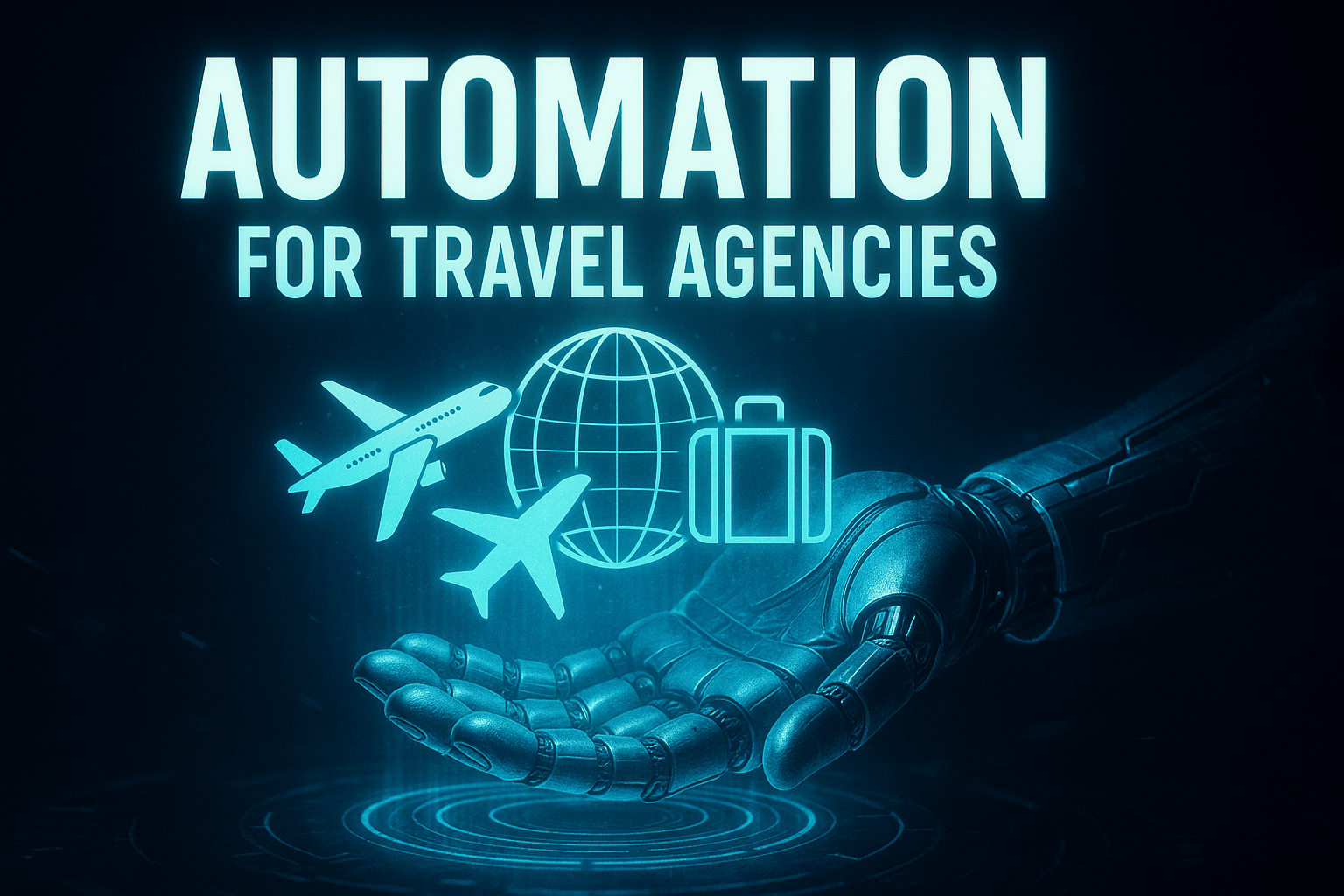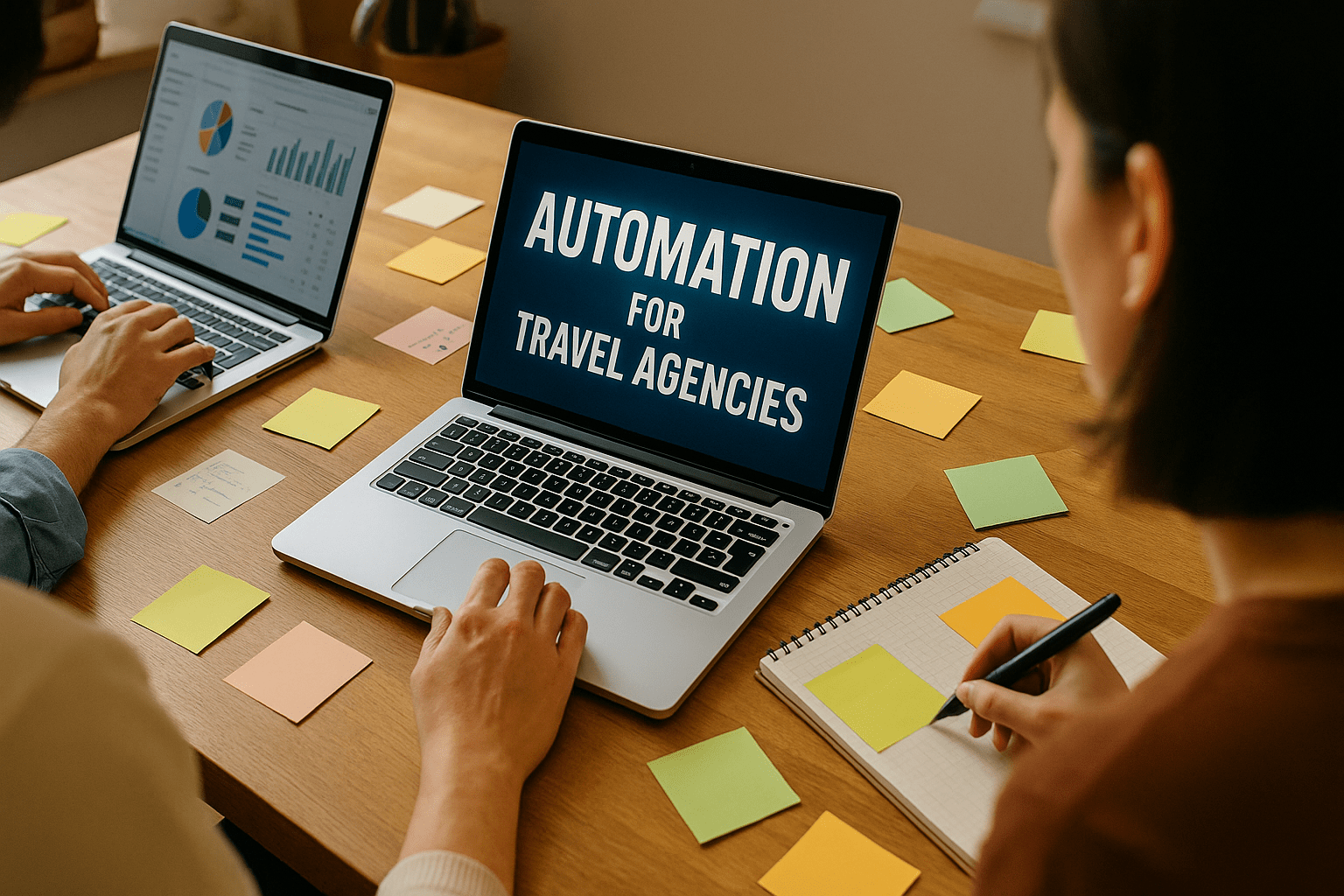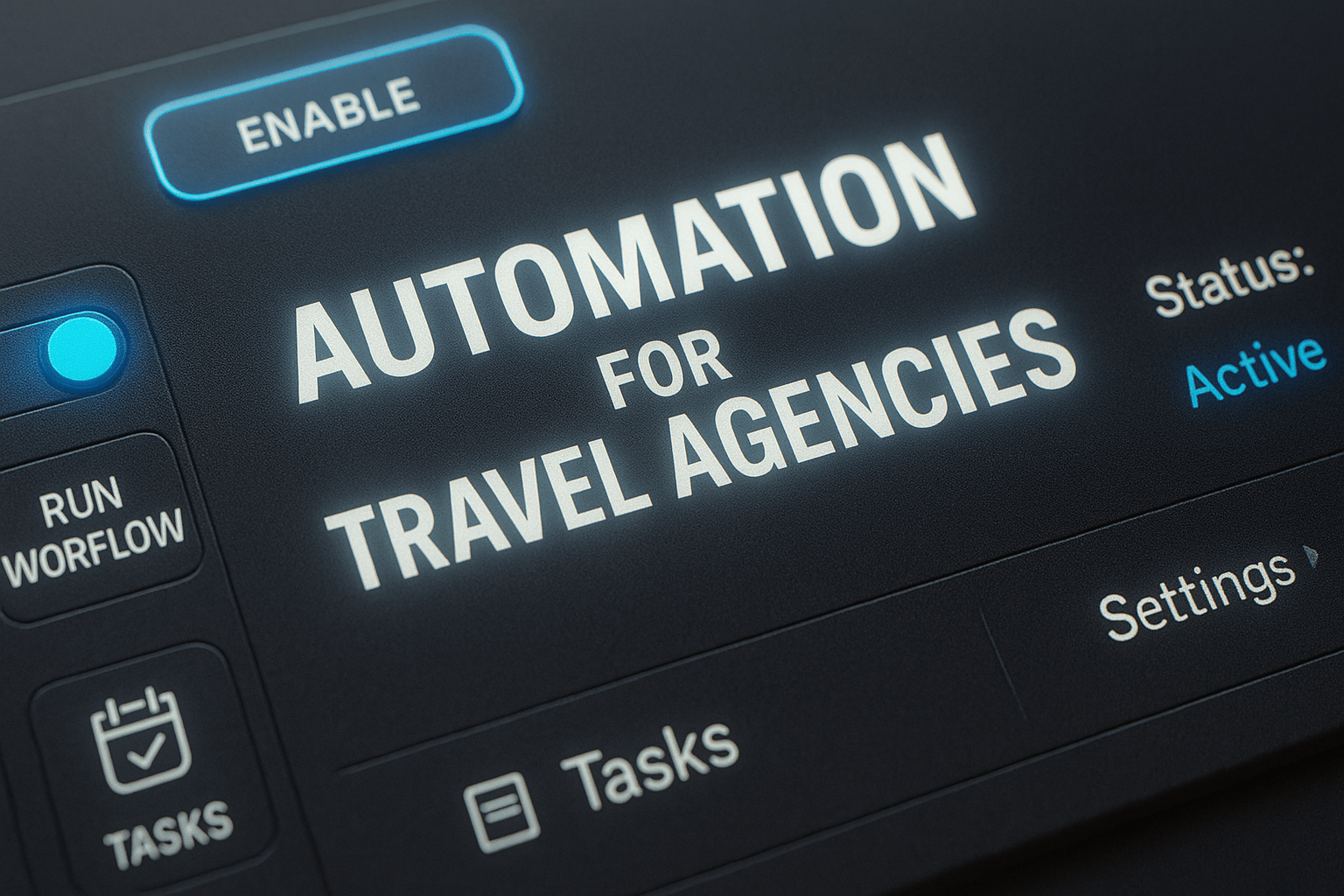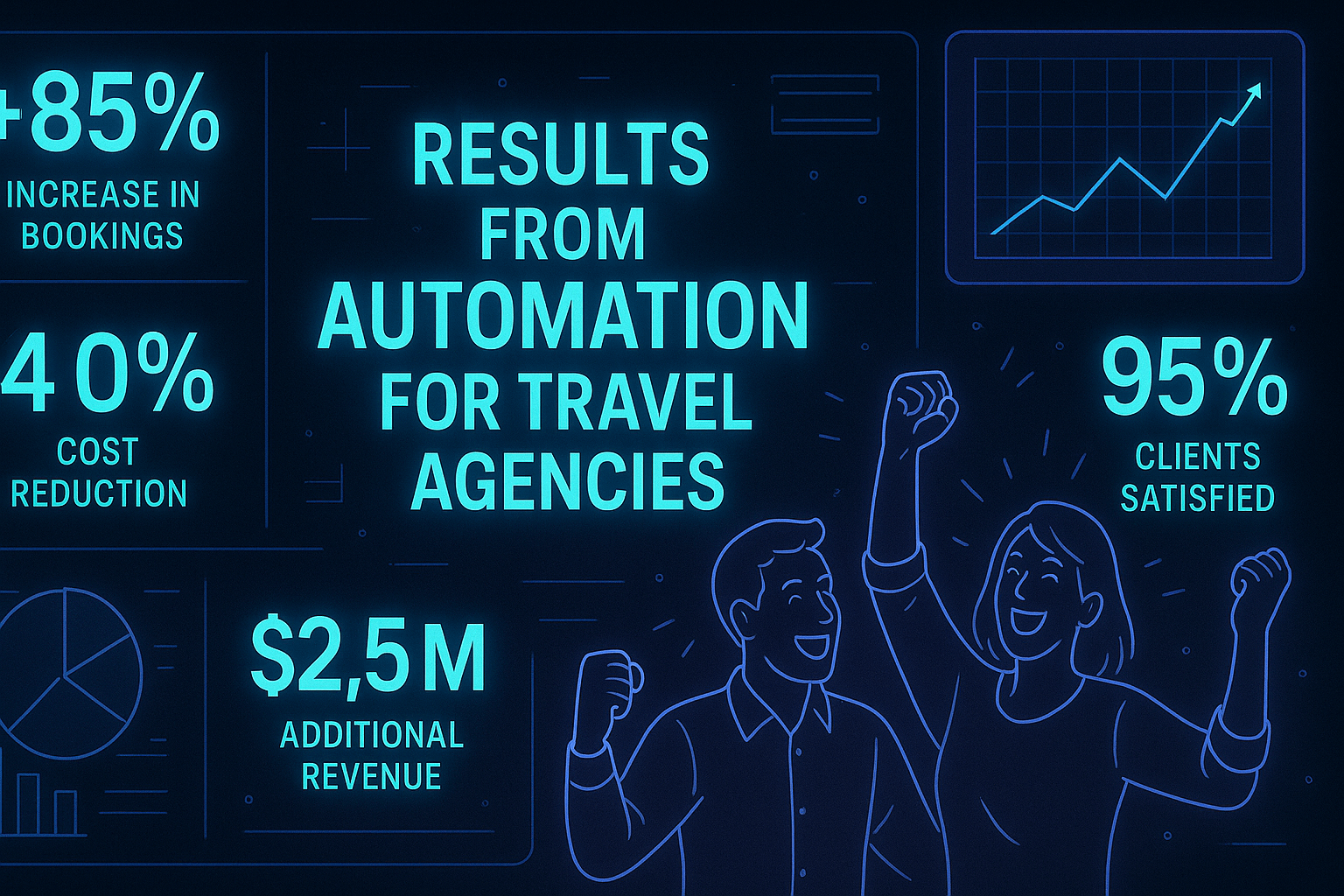How Automation for Travel Agencies Transforms Booking Operations and Customer Experience
by Design Delulu Editorial · October 12, 2025

The travel industry is experiencing a fundamental shift in how agencies operate and serve their clients. As customer expectations for instant responses and personalized service continue to rise, travel agencies face mounting pressure to deliver exceptional experiences while managing increasing operational complexity. Manual processes that once worked adequately now create bottlenecks, limit growth potential, and drain resources that could be better spent on strategic client relationships and business development.
Automation has emerged as the critical differentiator for travel agencies seeking to thrive in this competitive landscape. By implementing intelligent automation systems, agencies can transform time-consuming manual tasks into streamlined workflows, freeing agents to focus on high-value consultation and relationship building. This blueprint outlines a proven six-step methodology that enables travel agencies to harness automation's power while maintaining the personal touch that defines exceptional travel service. The result is a more efficient operation that scales profitably while delivering the responsive, personalized experience modern travelers demand.

Why Travel Agencies Need Automation Now
The travel industry operates in a uniquely challenging environment where multiple variables converge simultaneously. Travel agents juggle complex itineraries, coordinate with numerous suppliers, manage fluctuating pricing, handle last-minute changes, and respond to customer inquiries across multiple channels. Each booking involves dozens of touchpoints, from initial inquiry through post-trip follow-up, creating countless opportunities for delays, errors, and miscommunication.
Manual processes simply cannot keep pace with modern traveler expectations. Today's customers expect immediate responses to inquiries, real-time updates on their bookings, instant confirmation of changes, and proactive communication about potential disruptions. They compare travel agencies not just against other agencies, but against their experiences with tech-forward companies like Amazon and Uber that have set new standards for responsiveness and convenience.
Beyond customer experience, operational efficiency directly impacts profitability. Travel agencies operating with manual workflows face severe limitations on how many clients each agent can serve effectively. Administrative tasks consume valuable hours that could be spent on consultative selling, relationship building, and creating customized travel experiences that command premium pricing. Without automation, agencies hit growth ceilings determined by headcount rather than market opportunity.
Data fragmentation creates another critical challenge. Customer information, booking details, communication history, and preference data often scatter across email, spreadsheets, paper files, and various booking platforms. This fragmentation makes it nearly impossible to deliver truly personalized service, identify upsell opportunities, or track business performance accurately. Automation consolidates these disparate data sources into unified systems that provide complete visibility and enable data-driven decision making.
The Automation Advantage for Travel Agencies
Strategic automation implementation delivers transformative benefits across every dimension of travel agency operations. The most immediate impact appears in operational efficiency, where automated workflows can reduce task completion time by seventy to ninety percent for routine processes. Quote generation, booking confirmation, itinerary creation, payment processing, and follow-up communications that previously required hours of manual work now happen automatically, freeing agents to focus on activities that directly drive revenue.
Customer experience improvements manifest in multiple ways. Automated systems enable instant acknowledgment of inquiries, ensuring customers never wonder if their message was received. Intelligent routing directs inquiries to the most appropriate agent based on expertise, availability, and customer history. Automated notifications keep travelers informed throughout their journey with flight updates, gate changes, weather alerts, and local recommendations, creating peace of mind and demonstrating proactive service.
Personalization becomes scalable through automation. Systems can track individual customer preferences, travel history, special occasions, and feedback across all interactions. This data enables automated yet personalized communication that references past trips, suggests relevant destinations, acknowledges birthdays or anniversaries, and tailors recommendations to each traveler's unique interests and budget. The result feels highly personal while requiring minimal manual effort.
Revenue optimization benefits from automated pricing intelligence, dynamic packaging capabilities, and systematic upsell prompts. Automation can monitor competitor pricing in real-time, suggest optimal pricing for packages, identify opportunities to upgrade accommodations or add experiences, and ensure agents never miss chances to increase booking value. These incremental improvements compound into significant revenue gains.
Error reduction and quality control improve dramatically when automation handles data entry, booking confirmations, and document generation. Manual data entry inevitably produces errors that lead to incorrect bookings, missed connections, and customer frustration. Automated systems eliminate transcription errors, validate data consistency, and flag potential issues before they become problems, protecting both customer satisfaction and agency reputation.
Core Automation Systems for Travel Agencies
Successful automation strategies build on interconnected systems that work together seamlessly. Customer Relationship Management systems serve as the foundation, centralizing all customer data, communication history, booking records, and preferences in one accessible platform. Modern travel-specific CRM platforms integrate with booking systems, email, phone, and chat channels to create comprehensive customer profiles that inform every interaction.
Booking automation streamlines the entire reservation process from inquiry through confirmation. Intelligent forms capture complete customer requirements while minimizing friction. Integration with Global Distribution Systems and supplier platforms enables real-time availability checking, automated price comparison, and instant booking confirmation. Payment processing automation handles transactions securely while maintaining comprehensive financial records and triggering appropriate follow-up communications.
Communication automation ensures consistent, timely customer engagement throughout the travel journey. Automated email sequences nurture leads with relevant content, provide booking confirmations with complete details, deliver pre-trip preparation checklists, send travel documents, and trigger post-trip feedback requests. SMS automation enables time-sensitive notifications about flight delays, gate changes, or emergency situations that require immediate attention.
Document generation automation produces professional, accurate itineraries, vouchers, invoices, and travel documents instantly. Templates ensure brand consistency while dynamic fields populate customer-specific information automatically. Multi-language capability enables agencies to serve international clients effectively without manual translation effort.
Analytics and reporting automation transforms raw data into actionable insights. Dashboards display real-time metrics on booking volume, revenue, customer satisfaction, agent productivity, and marketing performance. Automated reports deliver regular updates to stakeholders without manual compilation. Predictive analytics identify trends, forecast demand, and highlight opportunities for intervention or optimization.
Marketing automation nurtures prospects and maintains engagement with past customers through targeted campaigns. Segmentation based on travel history, preferences, and behavior enables highly relevant messaging. Automated workflows guide leads through the consideration process with educational content, destination highlights, special offers, and timely follow-ups that maintain interest without requiring constant manual attention.

The Six-Step Implementation Blueprint
Successful automation implementation follows a structured methodology that ensures systems align with business objectives while maintaining operational continuity. This six-step blueprint provides a proven framework that travel agencies of any size can adapt to their specific needs and constraints.
Step One: Discovery and Goal Setting
Implementation begins with comprehensive discovery that maps current workflows, identifies pain points, and clarifies desired outcomes. This phase involves interviewing agents, managers, and customers to understand how work actually flows versus how it should flow. Process mapping reveals bottlenecks, redundancies, and opportunities for improvement that might not be obvious to team members working within the system daily.
Goal setting establishes measurable success criteria that guide implementation decisions and enable post-launch evaluation. Objectives might include reducing quote turnaround time from twenty-four hours to two hours, increasing bookings per agent by thirty percent, improving customer satisfaction scores, or decreasing administrative costs. Clear goals prevent scope creep and ensure automation efforts focus on highest-impact opportunities.
Constraint identification acknowledges real limitations around budget, technical capabilities, change management capacity, and timeline. Understanding these boundaries upfront enables realistic planning and prevents mid-implementation surprises that derail projects. Technical assessment evaluates existing systems, data quality, integration requirements, and infrastructure readiness.
Step Two: Strategy and Architecture Design
With clear understanding of current state and desired outcomes, strategic design defines the automation architecture that will bridge the gap. This involves selecting specific platforms and tools that align with agency needs, budget, and technical sophistication. Platform selection considers factors like ease of use, integration capabilities, scalability, vendor support, and total cost of ownership.
Workflow design reimagines processes to leverage automation while preserving essential human touchpoints. The goal is not to eliminate human interaction but to optimize where human expertise adds unique value. Automated systems handle routine tasks flawlessly, escalating to human agents when situations require judgment, creativity, or emotional intelligence.
Integration planning ensures all systems communicate effectively, eliminating data silos and enabling seamless information flow. API connections, webhooks, and middleware solutions create the technical infrastructure that allows data to move automatically between CRM, booking platforms, communication tools, and analytics systems.
Data governance establishes standards for data quality, security, privacy compliance, and access controls. Clear policies define what data gets collected, how it's stored, who can access it, and how long it's retained. This foundation prevents data quality issues that undermine automation effectiveness and ensures compliance with regulations like GDPR.
Step Three: Measurement Plan Development
Before implementation begins, comprehensive measurement planning establishes exactly how success will be tracked and evaluated. This includes implementing event tracking that captures key user interactions, configuring analytics platforms to collect relevant data, and creating dashboards that make performance visible to stakeholders.
Tracking plans document every event, metric, and data point that needs collection. This detailed specification guides technical implementation and ensures no critical data gets overlooked. Event taxonomy establishes consistent naming conventions that prevent confusion as systems scale.
Attribution modeling determines how credit gets assigned when multiple touchpoints contribute to a conversion. For travel agencies, this might involve understanding how email nurture campaigns, social media ads, content marketing, and agent outreach each contribute to booking decisions. Proper attribution enables accurate ROI calculation and informed budget allocation.
Baseline metrics capture current performance before automation launch, enabling accurate before-and-after comparison. Without solid baseline data, agencies cannot definitively prove automation impact or identify which specific changes drive improvement.
Step Four: Build and Configuration
Technical implementation translates strategic plans into working systems. This phase involves platform setup, integration development, workflow configuration, template creation, and rule definition. Build work follows established best practices for code quality, documentation, and testing to ensure reliability and maintainability.
Configuration involves detailed setup of business rules, triggers, conditions, and actions that define how automation behaves in various scenarios. Travel agencies must carefully consider edge cases and exceptions to prevent automation from creating problems in unusual situations. Fallback procedures ensure graceful degradation when systems encounter unexpected conditions.
Template development creates the emails, documents, and messages that automation will generate. Professional copywriting ensures communications sound natural and align with brand voice. Design work ensures visual consistency and mobile compatibility. Personalization tokens enable dynamic content that feels individually crafted.
Testing protocols verify that automation performs correctly under various conditions. Test scenarios cover normal operations, edge cases, error conditions, high load situations, and integration failures. User acceptance testing involves actual agents working with systems to identify usability issues before full rollout.
Step Five: Launch and Training
Successful launch requires more than just flipping a switch. Change management prepares the organization for new ways of working. Communication explains why changes are happening, what benefits team members will experience, and how their roles might evolve. Addressing concerns and resistance early prevents adoption problems.
Training ensures every team member understands how to work with new systems effectively. Hands-on practice with realistic scenarios builds confidence and competence. Documentation provides reference materials for ongoing use. Train-the-trainer approaches create internal champions who can support peers.
Phased rollout reduces risk by starting with limited scope or pilot groups before full deployment. This approach enables learning and refinement based on real-world use before systems are handling all operations. Quick wins from early phases build momentum and support for broader implementation.
Monitoring during launch identifies issues quickly so they can be addressed before they impact many customers. Support protocols ensure rapid response to problems. Feedback mechanisms capture user input that guides refinement.
Step Six: Optimization and Iteration
Launch is not the end but the beginning of continuous improvement. Ongoing optimization refines automation based on performance data, user feedback, and changing business needs. Regular review of analytics reveals which workflows perform well and which need adjustment.
A/B testing compares different approaches to identify what works best. Travel agencies might test different email subject lines, call-to-action placements, personalization strategies, or timing to optimize conversion rates. Systematic testing prevents assumptions from driving decisions when data could provide clear answers.
Expansion opportunities identify additional processes ready for automation. As teams become comfortable with initial implementations and demonstrate success, they build capability and confidence to tackle more complex automation challenges. Incremental expansion ensures sustainable adoption without overwhelming the organization.
Scaling successful automations amplifies impact. Workflows that prove effective for one market segment, service line, or team can often be adapted for others. Templates and frameworks developed during initial implementation accelerate subsequent projects.

Best Practices for Travel Agency Automation
Experience with hundreds of automation implementations reveals patterns that separate successful projects from disappointing ones. Following these best practices significantly increases the likelihood of achieving meaningful results.
Start with high-impact, lower-complexity processes that deliver quick wins. These early successes build organizational support for automation while teams develop skills and confidence. Avoid beginning with the most complex or politically sensitive processes, which can create resistance if anything goes wrong.
Maintain the human touch where it matters most. Automation should enhance rather than replace the personal relationships that differentiate exceptional travel agencies. Use automation to handle routine tasks so agents have more time for the consultative, creative, and relationship-building activities that customers value most.
Design with the customer journey in mind, not just internal efficiency. Every automation should improve customer experience or at minimum remain invisible to customers. Avoid automation that creates friction, confusion, or impersonal experiences that damage relationships.
Prioritize data quality from the start. Automation amplifies whatever you feed it, so garbage in means garbage out. Establish data standards, implement validation, clean existing data before migration, and maintain ongoing governance to keep information accurate and complete.
Build in flexibility and exception handling. Travel involves countless special cases, last-minute changes, and unique customer needs. Rigid automation that cannot accommodate variation creates frustration and forces workarounds that undermine efficiency. Design systems that handle common scenarios automatically while escalating exceptions to human judgment.
Measure what matters and use data to drive decisions. Implement comprehensive analytics from day one so you have visibility into what's working and what needs improvement. Establish regular review cadences that examine performance data and inform optimization priorities.
Invest in change management and training. Technology alone does not guarantee success; people must adopt and use systems effectively. Adequate training, clear communication, ongoing support, and celebrating successes creates the organizational culture that sustains automation benefits long-term.
Plan for integration and ecosystem thinking. Avoid creating new silos with automation platforms that don't communicate with other systems. Invest in integration work that enables seamless data flow and creates a unified technology ecosystem rather than a collection of disconnected tools.
Industry-Specific Considerations for Travel Agencies
Travel agencies face unique automation opportunities and challenges shaped by industry dynamics. Understanding these specifics enables more effective implementation that addresses real operational needs.
Seasonal demand fluctuations create periods of extreme workload variation. Automation helps manage peak season demand without proportionally increasing staff, while maintaining service quality during slower periods. Systems can automatically scale communication cadence, prioritize urgent inquiries, and ensure no opportunities slip through cracks during busy times.
Supplier relationship management involves coordinating with airlines, hotels, tour operators, ground transportation, and other service providers. Automation can streamline communication, track confirmation status, monitor service delivery, and flag potential issues requiring attention. Automated supplier scorecarding identifies partners consistently meeting standards versus those creating problems.
Regulatory compliance requirements around consumer protection, data privacy, and financial transactions create significant administrative burden. Automation ensures consistent compliance by building required disclosures, consent capture, and record-keeping into standard workflows. Audit trails document that proper procedures were followed.
Multi-channel customer engagement across phone, email, chat, social media, and in-person creates complexity in maintaining consistent experience and complete communication history. Omnichannel automation platforms unify these touchpoints, ensuring agents have complete context regardless of how customers reach out and enabling seamless channel switching without repeating information.
Dynamic pricing and availability require real-time information access. Automation can continuously monitor supplier systems, update availability, adjust pricing based on market conditions, and alert agents to time-sensitive opportunities. This responsiveness enables agencies to compete effectively with online booking platforms.
Complex multi-destination itineraries involve coordinating numerous components that must align perfectly. Automation can validate timing, flag potential connection issues, ensure logical routing, and assemble all components into cohesive packages. Changes to one element trigger automatic evaluation of impacts on other components.
Post-booking service represents significant opportunity for automation while requiring careful balance with personal touch. Automated trip preparation communications, travel updates, and post-trip follow-up maintain engagement throughout the customer journey. However, urgent issues or complaints must escalate immediately to human agents who can provide empathetic, flexible problem-solving.
Measuring Automation Success
Comprehensive measurement proves automation value and identifies optimization opportunities. Travel agencies should track metrics across operational efficiency, customer experience, financial performance, and agent productivity.
Operational efficiency metrics include average quote turnaround time, booking processing time, error rates, duplicate entry instances, and time spent on administrative tasks versus revenue-generating activities. Improvements in these metrics directly translate to capacity for handling more customers without proportional cost increases.
Customer experience metrics encompass satisfaction scores, Net Promoter Score, response time to inquiries, resolution time for issues, rebooking rates, and referral volume. These metrics reveal whether automation enhances customer perception of service quality or creates friction that damages relationships.
Financial performance metrics track revenue per agent, average booking value, conversion rate from inquiry to booking, customer lifetime value, and marketing ROI. Automation should ultimately drive top-line growth, improve margins, or both. Clear financial metrics enable accurate ROI calculation that justifies ongoing investment.
Agent productivity and satisfaction matter because automation's goal is not to eliminate staff but to make them more effective and satisfied. Metrics include bookings per agent, revenue per agent, time saved on routine tasks, agent satisfaction scores, and retention rates. Successful automation makes agents more productive and happier by removing tedious work.
Leading versus lagging indicators provide different perspectives on performance. Leading indicators like inquiry response time and quote delivery speed predict future success, while lagging indicators like revenue and customer satisfaction confirm results. Monitoring both enables proactive management.
Benchmarking against industry standards and competitors provides context for performance. Understanding typical metrics for travel agencies of similar size, market, and service model reveals whether your automation efforts are achieving competitive advantage or merely reaching par.
Frequently Asked Questions
Let’s level up your Travel Agencies business
Need services that actually move the needle for Travel Agencies? See our approach, pricing, and timelines—then book a quick call.
Additional Resources
- Schedule Your Automation Strategy Call
Book a complimentary consultation to discuss your travel agency's specific automation needs, challenges, and opportunities. Our specialists will assess your current workflows, identify high-impact automation opportunities, and outline a customized implementation roadmap tailored to your business objectives and budget.
- View Our Travel Agency Automation Portfolio
Explore real-world case studies showcasing successful automation implementations for travel agencies across various markets. See measurable results, workflow transformations, and client testimonials that demonstrate how strategic automation drives operational efficiency and revenue growth.
- Access Free Travel Agency Automation Tools
Download our collection of free resources including automation readiness assessments, workflow mapping templates, ROI calculators, and implementation checklists. These practical tools help travel agencies evaluate automation opportunities and plan successful implementations independently or as preparation for professional engagement.
Related Reading

Discover how automation for electricians streamlines scheduling, invoicing, lead tracking, and customer follow-ups to boost revenue and efficiency. Get started today.

Discover how automation streamlines furniture & home decor operations with GA4 tracking, attribution modeling, and data-driven dashboards. Get your 90-day implementation roadmap.
